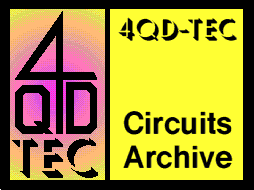

|
4QD-TEC
|
|
I have described elsewhere in these pages how normal PWM works in controlling the speed of a motor. PWPS is an entirely different system and two should not be confused: the similarity of names is unfortunate and I suggest you forget everything you know about ordinary PWM motor speed control so you can follow this explanation.
PWPS (you won't often find it referred to as this, but usually as PWM - which is confusing) is a control system which is extensively used in radio control to vary the rotation of (or position of), for instance, a rudder. It does this by using a small motor to rotate a shaft to which is attached a standard potentiometer. This output shaft is also coupled to the rudder - it is the angular rotation of this output shaft which is being controlled by the width of the input pulse being fed from the radio transmitter. These variable width pulses are fed at intervals.
The angular rotation of this output shaft is monitored via a feedback pot inside the servo mechanism, this pot then causes the output shaft to be 'slaved to ' the transmitted pulse. The word 'servo' in fact means nothing other than slave and comes from the Latin Servus - a servant.
The system is defined as being centred at a pulse width of 1.5mSec. Pulse repetition rate is not important, a typical rate might be 400Hz (2.5mS pulse spacing) or 50Hz (20mS spacing). Rate of change of pulse width with rotational angle is 10µS per degree with a range of 90° (±45°). Therefore maximum pulse length is 1.95mSec and minimum is 1.05mSec (1.5mSec ±450µsec).
Now if you were trying to work out how to give a signal which depends on the rotation of a pot, one way you might chose is by using the pot to control the pulse width of a common mono-stable.
This is exactly what PW PS does. Every time the receiver gets a pulse from the transmitter, it fires a monostable. The monostable's pulse width is determined by the pot on the output shaft. The receiver compares the received pulse with the monostable's pulse. If the received pulse stops first then the receiver causes the motor to rotate anticlockwise so the monostable's pulse length is reduced. If the local pulse stops first then the motor is rotated clockwise, to increase the local pulse length.
The commonest 'home constructor' chip for this application used to be the ZN409 (GEC-Plessey Semiconductors). The ZN 409 contains the receiver monostable (which needs external timing components) and most of the drive components to control a small, 6v motor. It also contains other bits of circuitry to tailor the motor response and to include a dead band, to reduce overshoot and hunting.
This chip has been rendered obsolete because manufacturers nowadays use dedicated microcontrollers for the job.
It is of course quite simple to interface such a system to a 4QD controller. You would fix a second pot (10K) onto the output shaft and feed this to a joystick interface board. The JSI will drive a standard VTX series controller. However see also Radio control.
If the pulse repetition time is high (400Hz, as above) then the 1.5mS is a 60% duty cycle. 90° forward is 96% duty cycle and 90° reverse is 24% modulation. A 6v signal with 24% duty cycle has an average of 1.4v, 60% gives 3.6v and 96% gives 5.8v. With this system the pulse train could feed direct to, say, a 2QD controller and the ramping circuit in the controller would average out the pulse train, converting it directly to a demand speed value.
However life with your r/c signal will probably not be that simple: pulse repetition frequencies vary a lot and are not neccessarily stable. For instance a dual channel transmitter might have a 20mS rate, transmitting first a pulse for one channel, then for the second channel. A 1mS pulse every 20mS is only 5% duty cycle and there is not going to be enough variation to use this signal directly.
| 4QD Sites: |